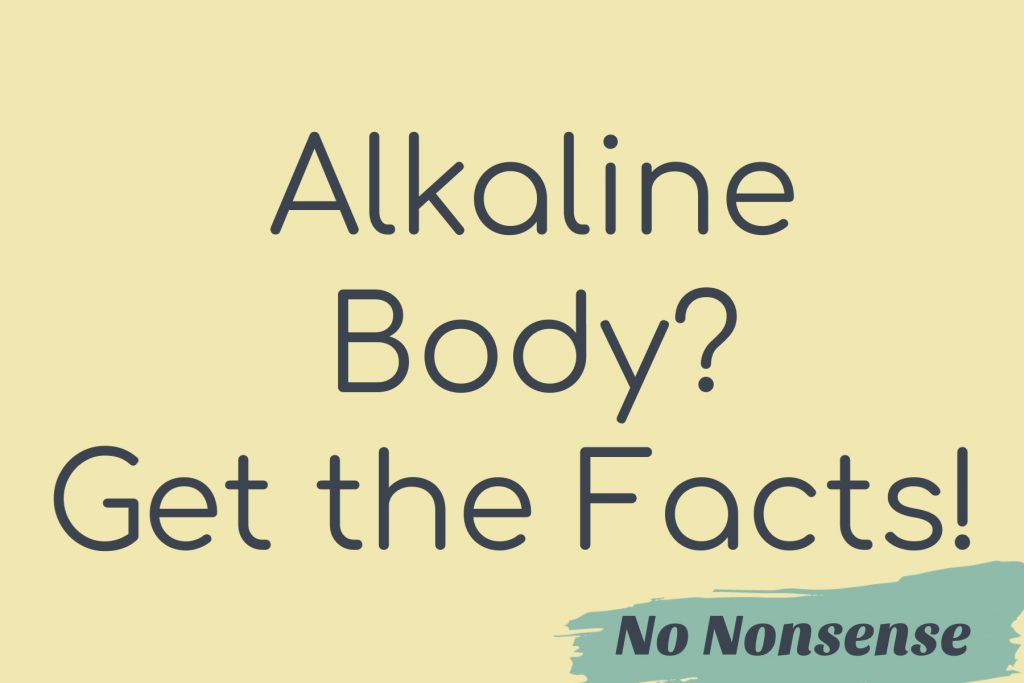When cooking for my family, my primary concern is nutrition optimization (consuming, absorbing, retaining, and utilizing all of the necessary nutrients as best as possible). Nutrients rule all bodily functions, including pH homeostasis of the blood, cells, saliva, etc. When choosing foods, what I want to know is what are the nutrients the food offers and what is the availability of those nutrients.
The notion of alkalizing the body is, and has always been, misguided and inaccurate. Unfortunately, it’s something that is promoted by individuals who speak of health, yet they don’t know the basic physiological or biochemical functions of the body. In essence, the body regulates itself to maintain proper pH in different areas. We have help with that regulation from important bacteria when it comes to certain areas like our skin, intestines, and vagina (for women). The helpful bacteria are with us from birth and we depend on them for optimization of many other things, including digestive function, brain function, immune system function, etc.
Basic facts about the so-called alkaline body:
1. The so-called alkaline diet fails to take several aspects of total health into consideration. This is especially true when it comes to the intestinal bacteria. While you can feed them well with fiber and resistant starch (which is plentiful in the “alkaline diet”), the bacteria also rely on certain nutrients that tend to be very low in plant-based diets (like vegan, vegetarian, alkaline diets), including zinc and iron.
2. Most foods have a pH under 6, and all have a pH under 7. However, focusing on the pH of foods reduces focus on overall nutritional content and availability of essential nutrients. All nutrients need to be addressed daily. pH has nothing to do with this, and diets that focus on the pH theory are lacking sufficient amounts of several vital nutrients. Various combinations of nutrients are required for every single function in the body, including overall pH homeostasis.
3. Some alkaline diet proponents state/suggest that the pH of the body is changed by food, and it’s often taught as though the pH is either made alkaline/basic or acidic with each meal. Some even say that the pH of the food itself is what indicates whether it will affect the pH of the body. However, many whole foods that are said to be acid, acidic, and/or acidifying to the body actually contribute to overall homeostasis. This includes meats and dairy.
4. The body doesn’t have ONE pH range. It has different pH ranges in different areas. Mouth should be alkaline, the blood and cells are alkaline, the stomach, skin, hair, vagina are very acidic, intestinal pH ranges from 5.5 to 7.5, but most of the intestines stay below 7 (acidic). So, WHAT is an alkaline body? It doesn’t exist. The closest you can get to it is something called alkalosis, which you definitely don’t want because it’s unpleasant and fatal.
5. When it comes to blood pH, the body tightly regulates it, and having a very alkaline/basic blood pH is just as detrimental as having a very acidic blood pH. The pH of our blood (7.35 – 7.45) is much closer to neutral (about 7). It’s just barely alkaline. If your pH becomes more alkaline or acidic, something is very wrong and it has nothing to do with the pH of what was eaten. However, consuming foods or drinks with a high/alkaline pH can significantly interrupt digestion, especially in those with poor stomach acid production.
6. Drinking liquids with a pH of more than 8 isn’t recommended. Definitely nothing higher than 9. There are quality spring waters with a pH between 7 and 8. Water’s normal pH is neutral (7). Water that is more alkaline (like spring water) has bicarb that increases alkalinity. We have no need for high amounts of bicarbonate in our water. Bicarbonate neutralizes acid, slowing or even halting proper digestion of proteins and fats in the stomach. The interesting, yet ridiculous, water tests scaring people about water pH (typically to sell some other water) often show certain brands of bottled water to be acidic. They don’t discuss the difference between the waters tested. Distilled water and purified water have had most/all minerals removed (this is why they tend to taste “flat”). This makes them prone to absorption of carbon dioxide, although typically less than the amounts you’d find in carbonated water. This influences the pH. Otherwise, the pH would be neutral because it would be pure water (water with nothing else to it, just H2O). Spring water has several minerals and bicarbonate is usually present. This makes the water have a slightly higher pH, but not usually much higher than 9. These folks selling water with pH above that are selling you a problem (they don’t even know it).
7. No matter what the pH of a food is, it is all washed in acid in the stomach, then all of it is bathed in alkaline/bicarbonate before it goes into the small intestines. This is so that the food sludge is less acidic as it goes through the intestines and interacts with stomach lining and stomach bacteria. The intestines must be acidic, they don’t do well with alkalinity, but not nearly as acidic as the stomach.
8. There are claims that cancer can’t live in an alkaline environment. Many use this statement, or a more general “disease can’t live in an alkaline environment” (which is absurd) to convince others to see things their way. Unfortunately, their way doesn’t actually have anything to do with human physiology or oncology. Cancer cells prefer and need the same pH as our normal cells. As a matter of fact, they use a lot of energy trying to maintain an internal alkaline pH. Because of this, any acids that they produce (all cells produce acids, not just cancerous ones) are pushed out into the blood stream. They are more efficient at metabolizing things than normal cells are, and thus they can produce more acid. They don’t NEED this acid to survive. What they NEED is access to more nutrients, which is why they increase connection to the blood stream through creation of more blood vessels. Many cancer cells were normal cells that mutated as an attempt to survive after long-term deficits in nutrition, constant exposure to free radicals (which impede access to nutrients), and unchecked exposure to toxins/carcinogens (which significantly reduces nutrient availability also).
Focus on giving the body the nutrition that it needs, and all else can be allowed to happen as nature intended.
Rebel Well!
